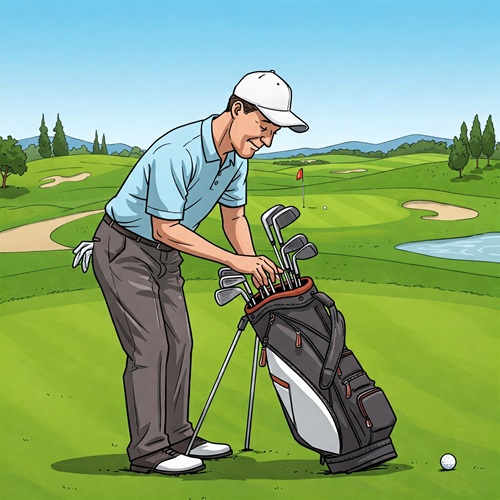What Wedges Should I Carry?
When putting your golf bag together, one of the biggest questions every golfer faces is: what wedges should I carry to the course?
We all know golf wedges are essential scoring clubs for the short game for handling those tricky, delicate shots from 135 yards and under.

For many golfers struggling to make the leap to the next handicap level, the right wedge can help them save par or get that golf ball closer to the pin on a pitch shot.
In this article, we’ll discuss how many wedges you should carry and how having more clubs with higher lofts can help fill distance gaps, provide more control, and lower your scores.
Types of Wedges
There are four main types of wedges that golfers typically place in their golf bag.
Pitching Wedge
Usually included in your iron set, pitching wedges typically have 44 to 48 degrees of loft. They’re designed for longer full shots and provide less loft than other wedges.
The best pitching wedge is essential for approaches from the fairway.
Gap Wedge
As the name suggests, this club fills the “gap” between your pitching wedge and sand wedge.
With approximately 50 to 53 degrees of loft, the gap wedge gives you more options for those mid-distance shots where a pitching wedge is too strong and a sand wedge isn’t enough.
Sand Wedge
With 54 to 58 degrees of loft, the sand wedge was originally designed for bunker play. The sand wedge features more bounce on the sole, which helps the club glide through sand rather than digging.
However, it’s versatile enough for various shots around the greens and from the fairway.
Lob Wedge
The lob wedge has the highest loft (58 to 64 degrees) of all wedges and is designed for shots requiring height and a soft landing.
It’s beneficial for shots over hazards, tight lies, or when you need to get the ball up quickly with maximum height.
Determining the Right Number of Wedges
How many wedges should you carry?
This depends on several factors, including your skill level, swing tendencies, and the types of golf courses you play.
Most professionals and low handicappers carry four wedges to give themselves more options for particular shots and precise distance control.
High handicappers might benefit from carrying three wedges, focusing on versatility rather than specialization.
If you’re limited by the 14-club rule and want an extra fairway wood or hybrid in your bag, you might choose to carry fewer wedges.
However, remember that roughly half your shots in nine holes or over a full round of golf occur within wedge range, making these clubs the right tools to unlock your scoring potential.
Wedge Loft and Gaps
Creating consistent gaps between your wedges is crucial for distance control. Most experts recommend 4 to 6-degree loft gaps between each wedge in your setup.
For example, if your pitching wedge is 46 degrees, a logical gap structure might be:
- Pitching Wedge: 46 degrees
- Gap Wedge: 50 degrees
- Sand Wedge: 54 degrees
- Lob Wedge: 58 degrees
This 4-degree spacing helps eliminate awkward distances where you’re between clubs.
When selecting your wedges, consider the loft and bounce, which is the angle between the leading edge and the lowest point of the sole that touches the turf.
High bounce wedges (10 to 16 degrees) work better for soft sand, thick rough, or high handicappers with steep swing paths. Low bounce wedges (4 to 6 degrees) excel on tight lies, firm sand, and for players with shallow swings.
Choosing the Right Wedges for Your Game
When selecting wedges, consider these factors:
Course Conditions
If you play courses with firm greens and tight lies, lower bounce options might serve you better. For courses with soft sand bunkers and lush rough, higher bounce wedges provide more forgiveness.
Swing Type
Players who tend to dig with steep angles of attack usually benefit from more bounce to prevent the club from digging too deeply. Players with a sweeping motion typically need less bounce.
Shot Type
Consider what shots you commonly face. If you often play from cart paths or need to hit flop shots over bunkers to tight pins, the best lob wedge becomes more valuable.
If you rarely face such scenarios, you might prioritize other clubs.
Grind Options
Modern wedge design includes various sole grinds that remove material from the heel, toe, or trailing edge of the club.
These modifications can enhance versatility, allowing for open-faced shots or better performance from different lies.
What wedges should I carry?
Frequently Asked Questions
What wedges should every golfer carry?
Every golfer should carry at a minimum a pitching wedge and a sand wedge. More skilled players benefit from adding a gap wedge and a lob wedge.
The ideal setup utilizes a consistent 4-degree gap between wedges to cover all distances within 135 yards.
Should I have a 52, 56, and 60 degree wedge?
Yes, a 52, 56, and 60-degree wedge setup provides excellent versatility. The 52° handles mid-range approaches, the 56° works for bunker shots and standard chips, and the 60° gives you options for high flop shots and tight lies.
Should I carry a 58 or 60 degree wedge?
This choice depends on your skill level and course conditions. A 58° offers slightly more forgiveness and distance, while a 60° provides maximum height and stopping power.
Consider your comfort level with high-lofted clubs and whether you frequently need flop shots around firm greens.
Is it better to chip with a 56 or 60 degree wedge?
For standard chips, a 56-degree wedge is generally better as it provides more consistency, forgiveness, and a lower ball flight with more roll.
Save the 60-degree for when you need to clear hazards, stop the ball quickly, or have limited green to work with.